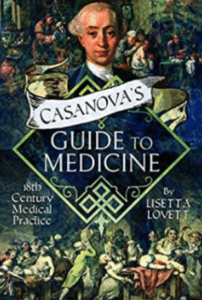Arpan K. Banerjee
Solihull, United Kingdom

Cover of Casanova’s Guide to Medicine by Lisetta Lovett.
The eighteenth-century Italian Giacomo Casanova (1725–1798) is today best remembered for legendary amorous pursuits that resulted in his name becoming a part of the English language. What has been forgotten, however, is that he was a remarkable and erudite polymath. He graduated as a lawyer from the University of Padua at seventeen but did not want to practice law, preferring medicine instead. He was acquainted with the writings of Boerhaave of Leiden, one of the foremost physicians of his time. He was a talented linguist, a soldier, a clergyman, a businessman, a mathematician, diplomat, violinist, and a con man who spent time in prison. He was also was an accomplished man of letters who wrote over forty books including plays, many letters, and a remarkable twelve-volume story of his life.
In this new, well-researched book by psychiatrist and medical historian Lisetta Lovett, Casanova’s considerable medical interests are explored and placed in their historical and cultural context, giving an interesting overview of eighteenth-century medicine. Topics include Casanova’s writing on “the pox” (syphilis), a common disease at that time that had little or no treatment. He calls syphilis “the French disease” and describes the clinical symptoms of the venereal diseases that he contracted and often self-treated with mercury. He wrote extensively about women’s health concerns, sexual practices, and taboos, as well as infectious diseases such as smallpox that were prevalent in his day. His writing on the plague and quarantine hold particular interest in our current times. Fever, influenza, and gout were topics of additional inquiry as well as skin conditions. He suffered from depression and wrote about mental illness and suicide. Casanova also wrote about accidents, dueling injuries, surgical interventions, and therapeutics, including smelling salts and other potions for treating disease. Casanova even had an interest in medical ethics and etiquette.
The author, Lisetta Lovett, analyzes Casanova’s medical writings within the context of his time, making the book not only a rich source of Casanova’s contributions to medical knowledge but also a chronicle of eighteenth-century life and medical practice. The book is extensively referenced and accompanied by a bibliography for further reading. It reminds us that Casanova was a remarkable character who deserves to be remembered for more than his amorous adventures.
Casanova’s Guide to Medicine
Lisetta Lovett, 2021
Pen and Sword Ltd, UK
ISBN 9781526779212
ARPAN K. BANERJEE, MBBS (LOND), FRCP, FRCR, FBIR, qualified in medicine at St. Thomas’s Hospital Medical School, London. He was a consultant radiologist in Birmingham from 1995–2019. He served on the scientific committee of the Royal College of Radiologists 2012–2016. He was Chairman of the British Society for the History of Radiology from 2012–2017. He is Chairman of ISHRAD and adviser to Radiopaedia. He is the author/co-author of numerous papers and articles on a variety of clinical medical, radiological, and medical historical topics and seven books, including Classic Papers in Modern Diagnostic Radiology (2005) and The History of Radiology (OUP 2013).

Leave a Reply